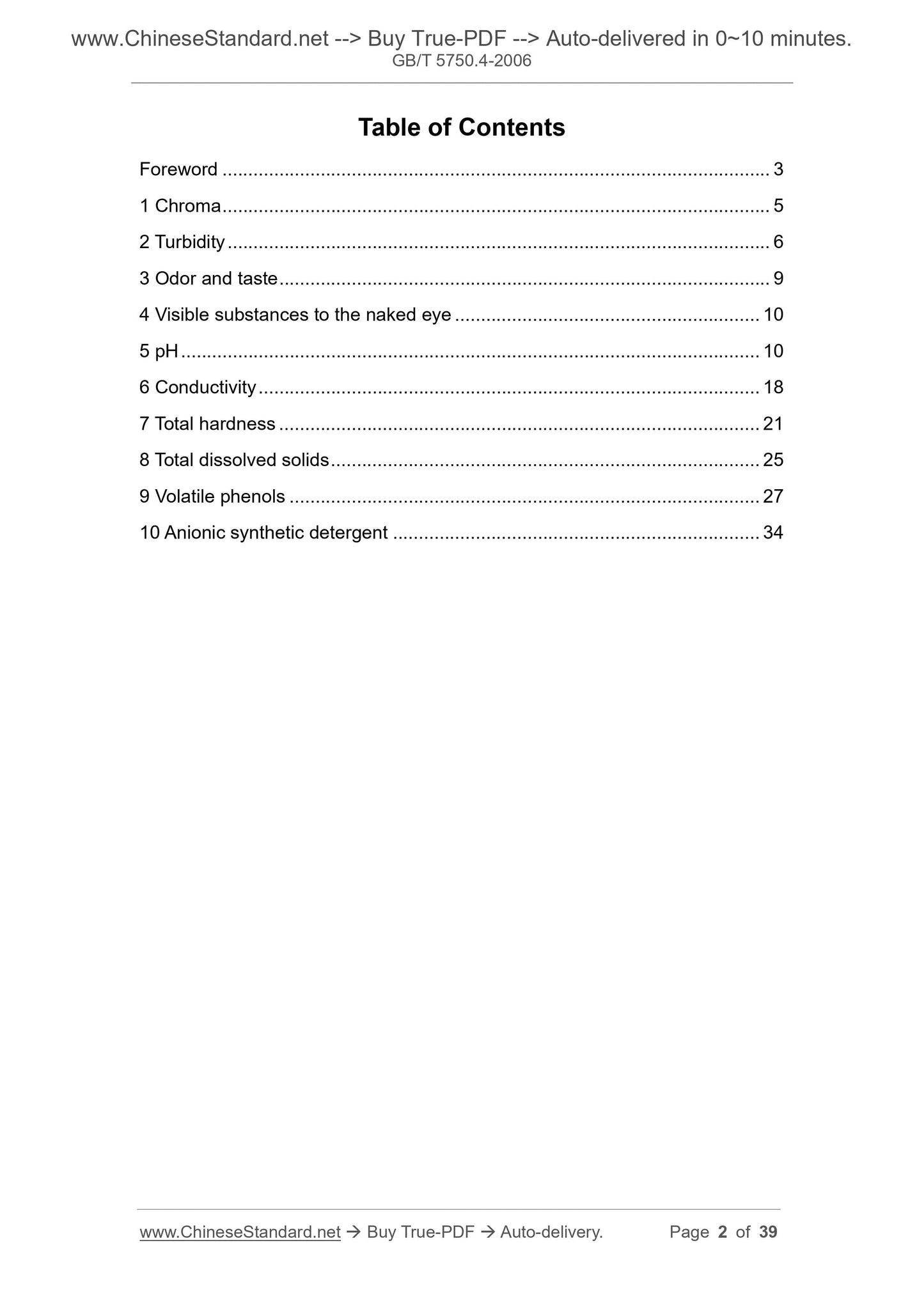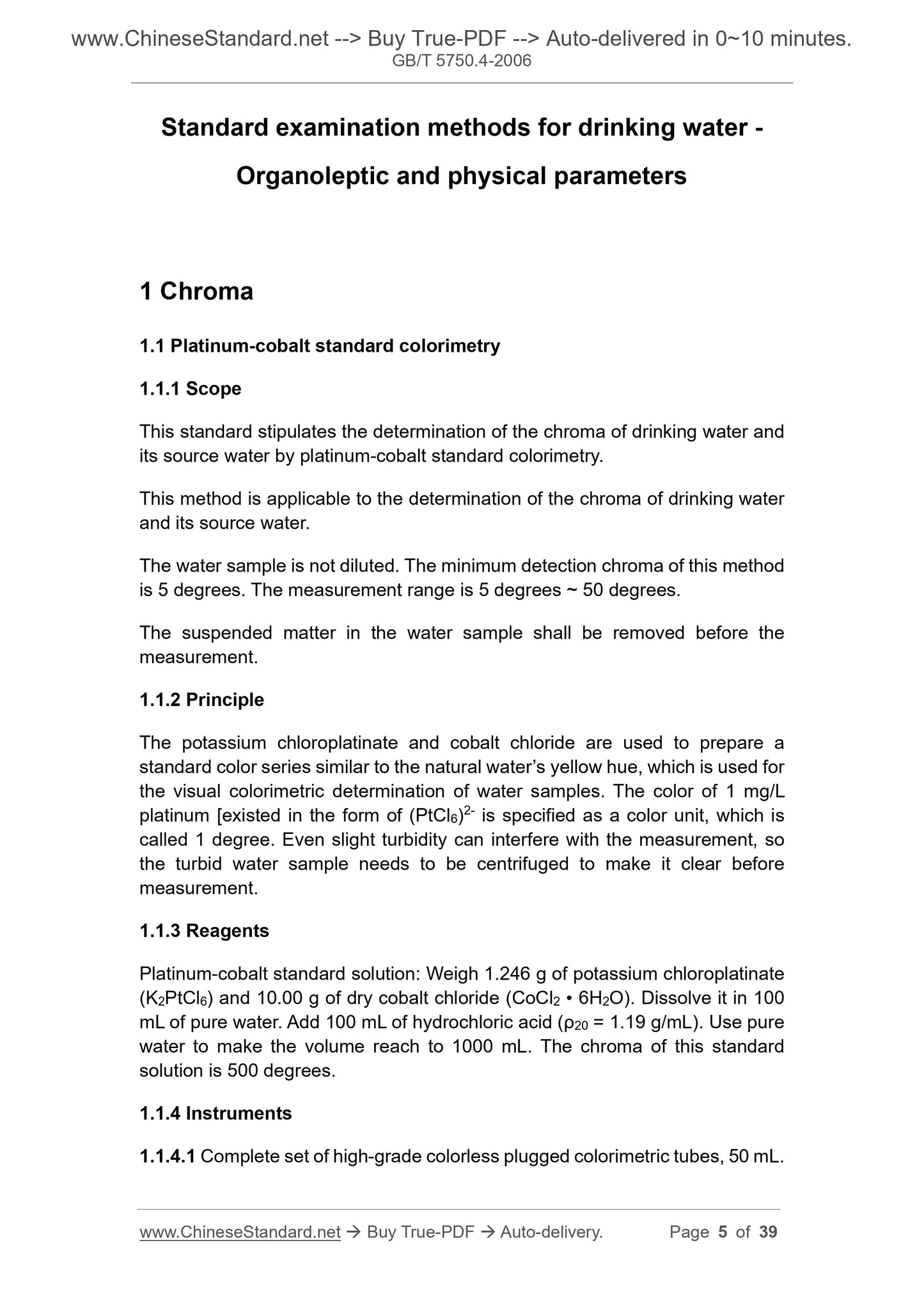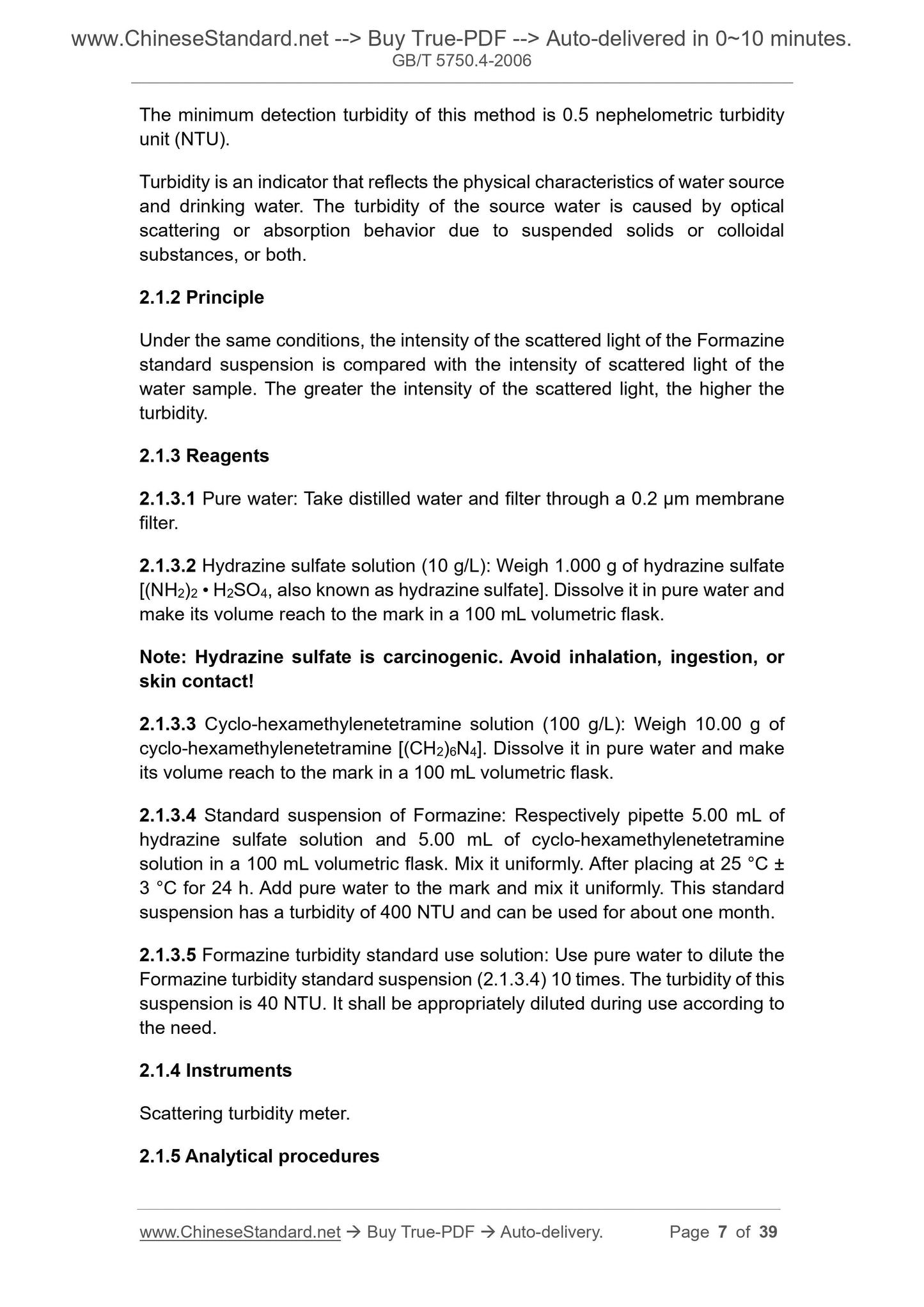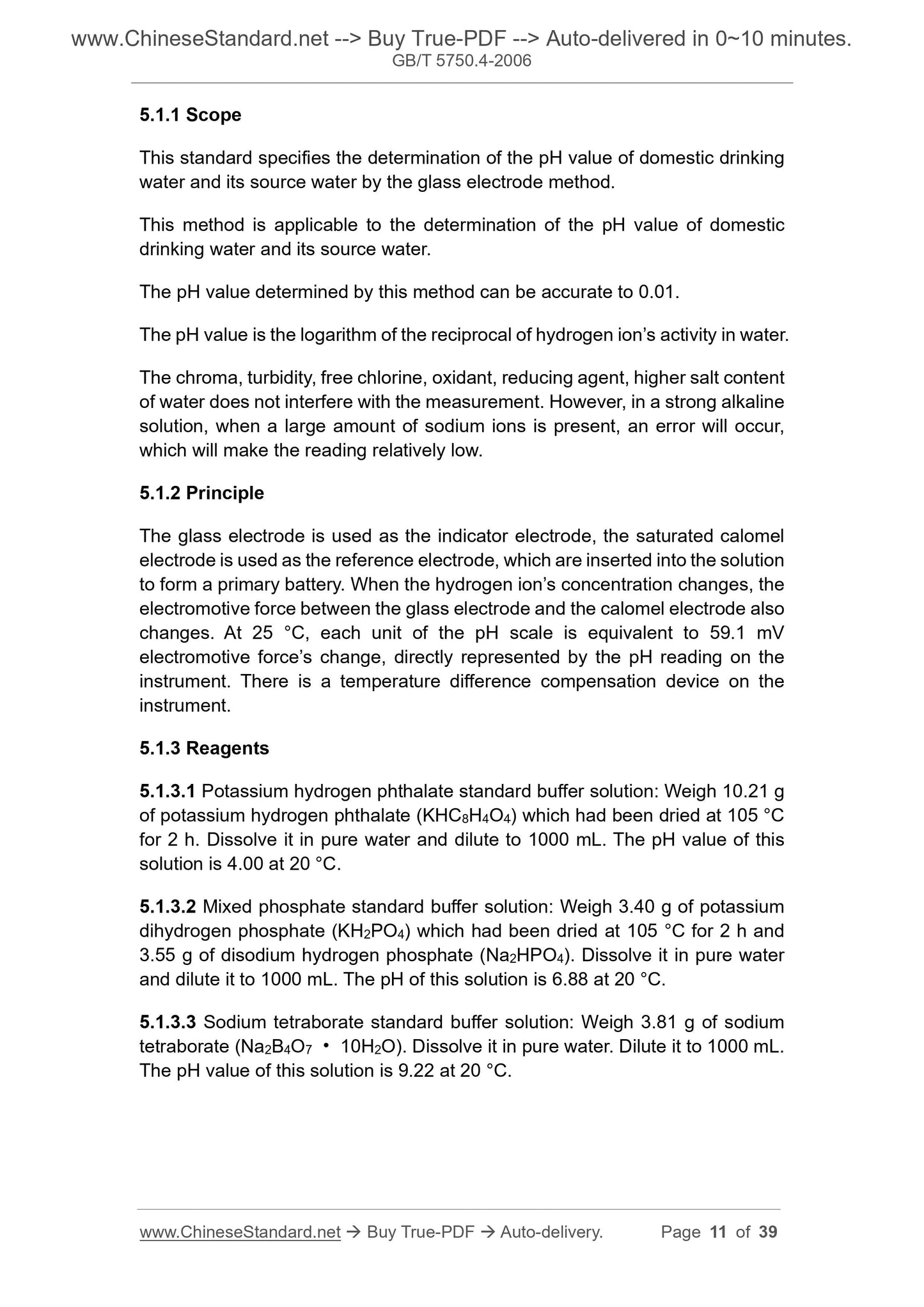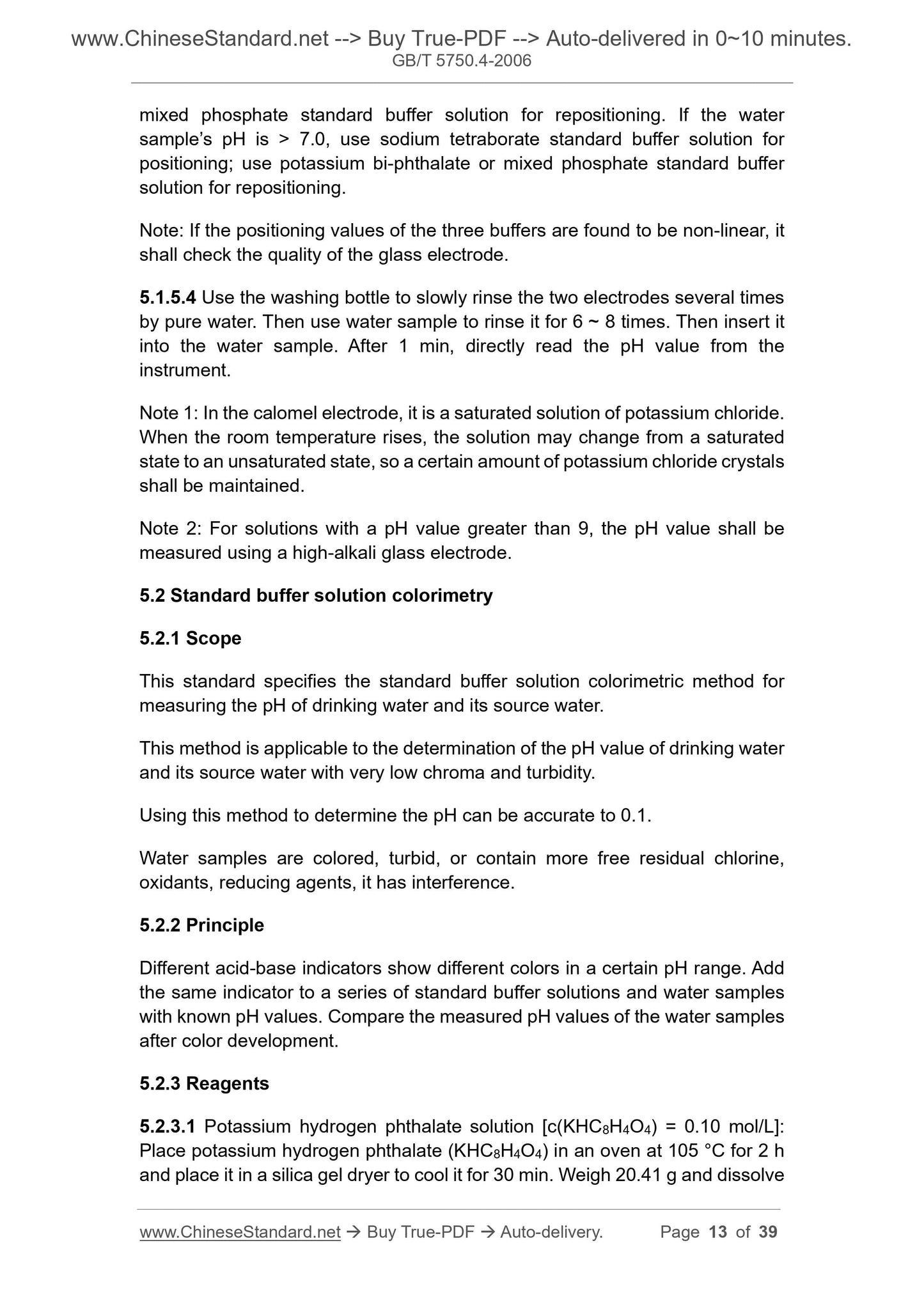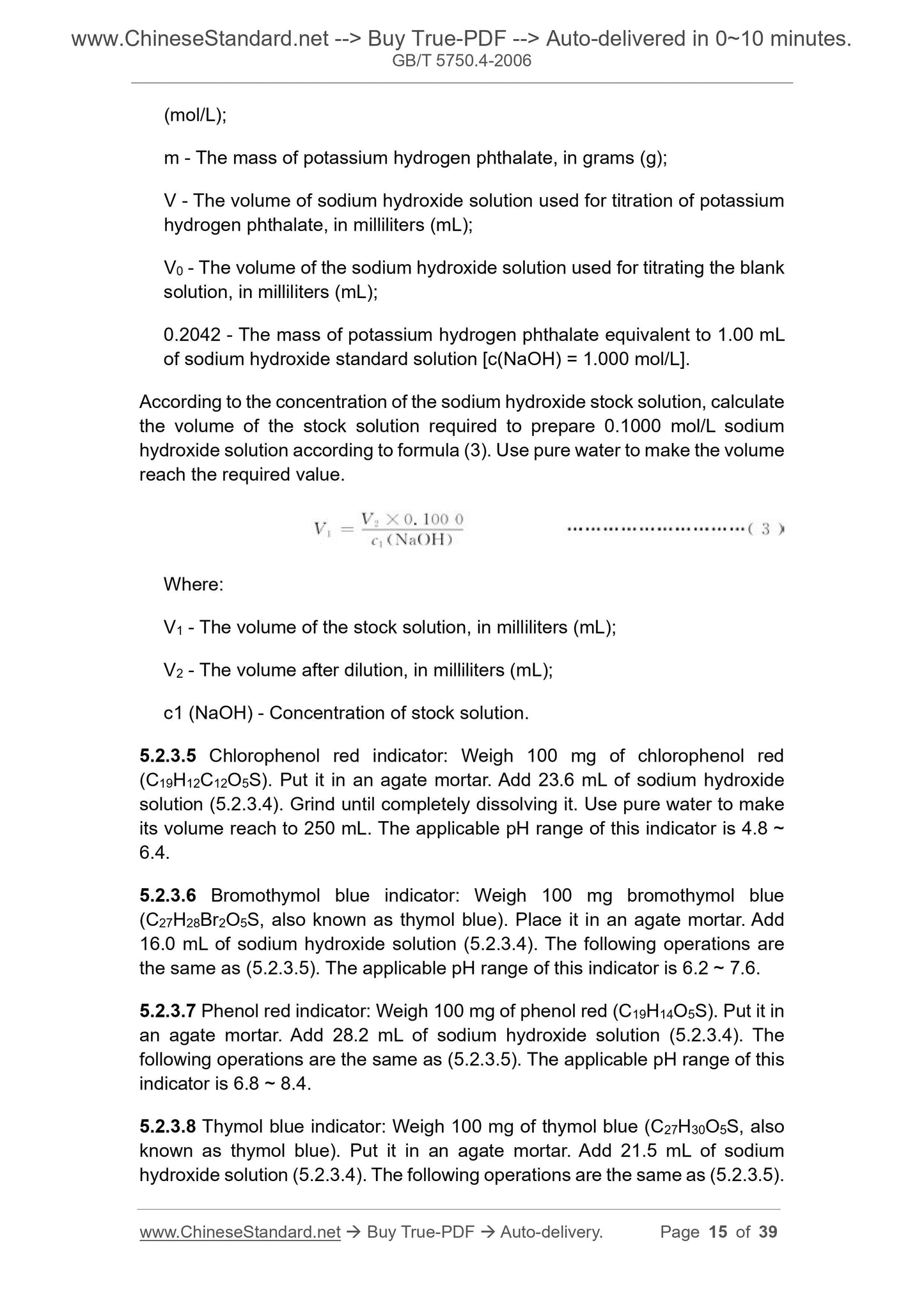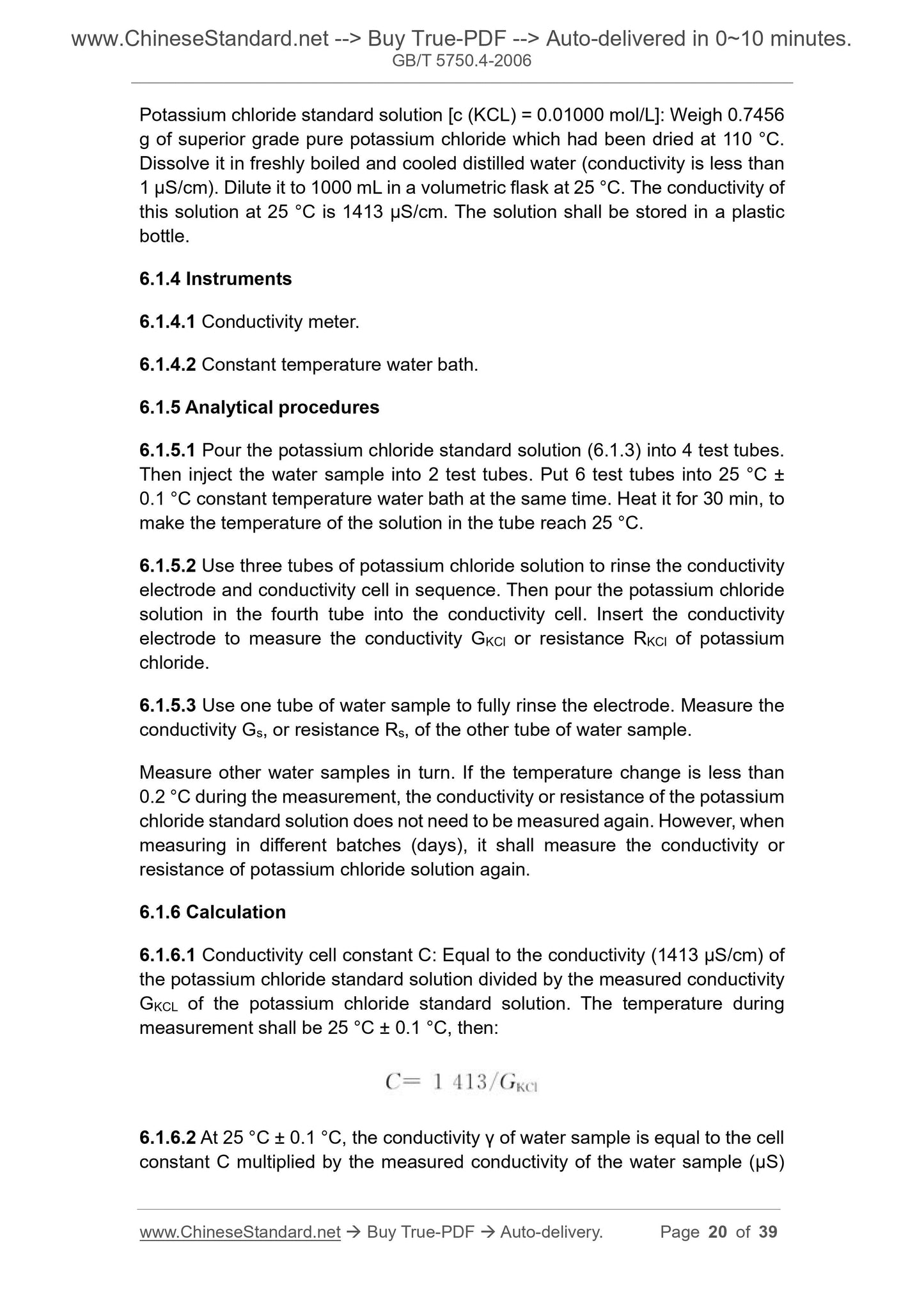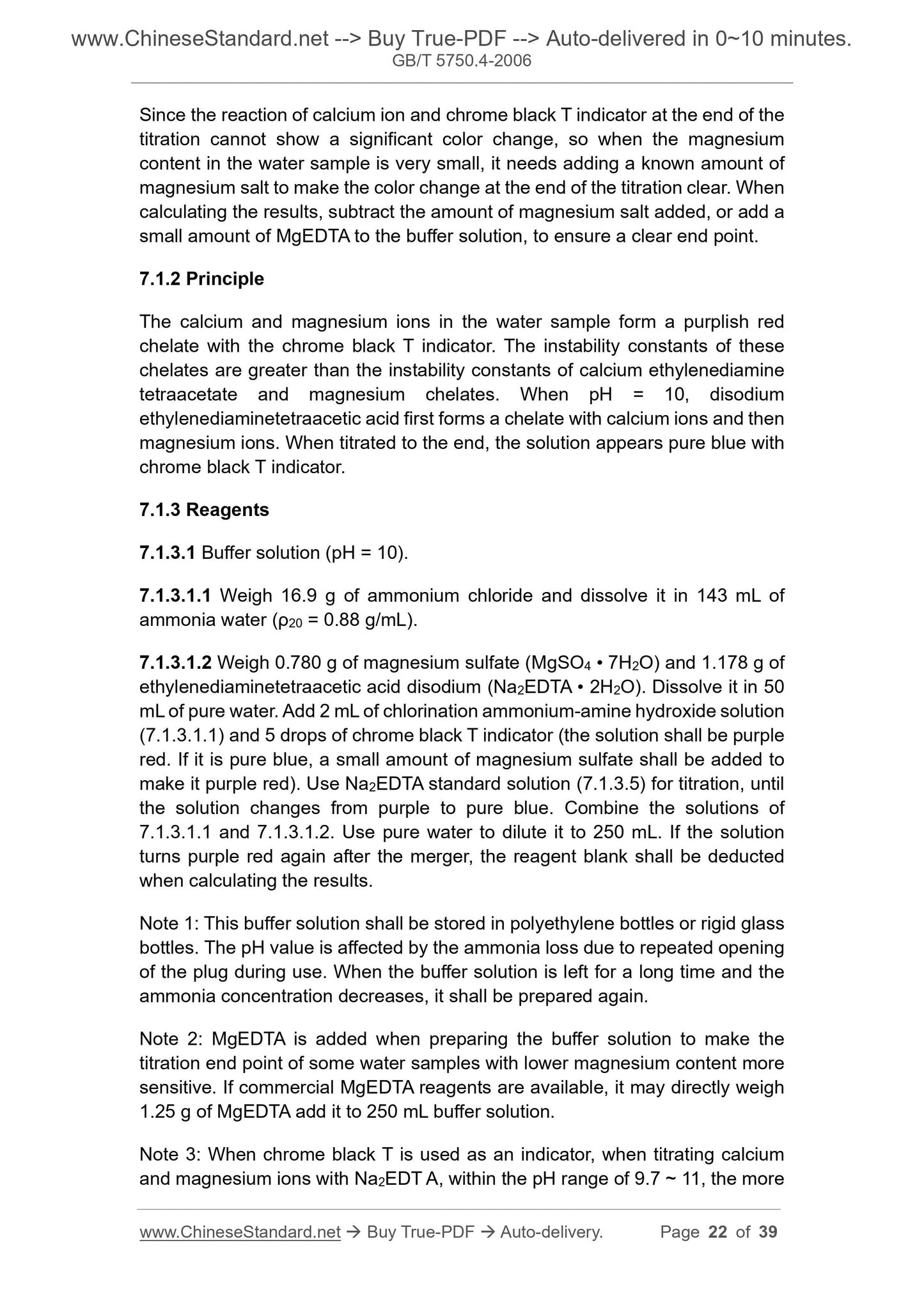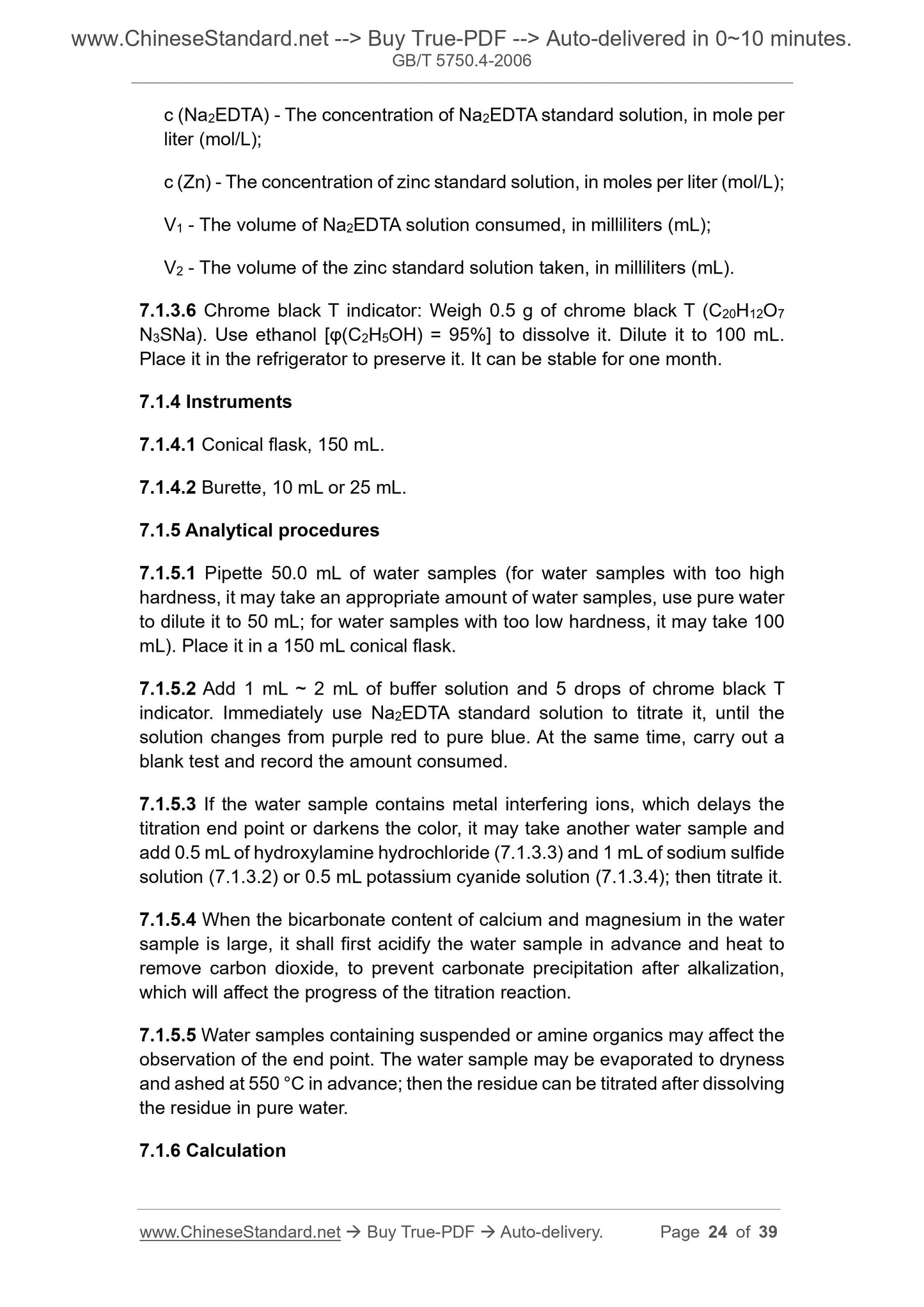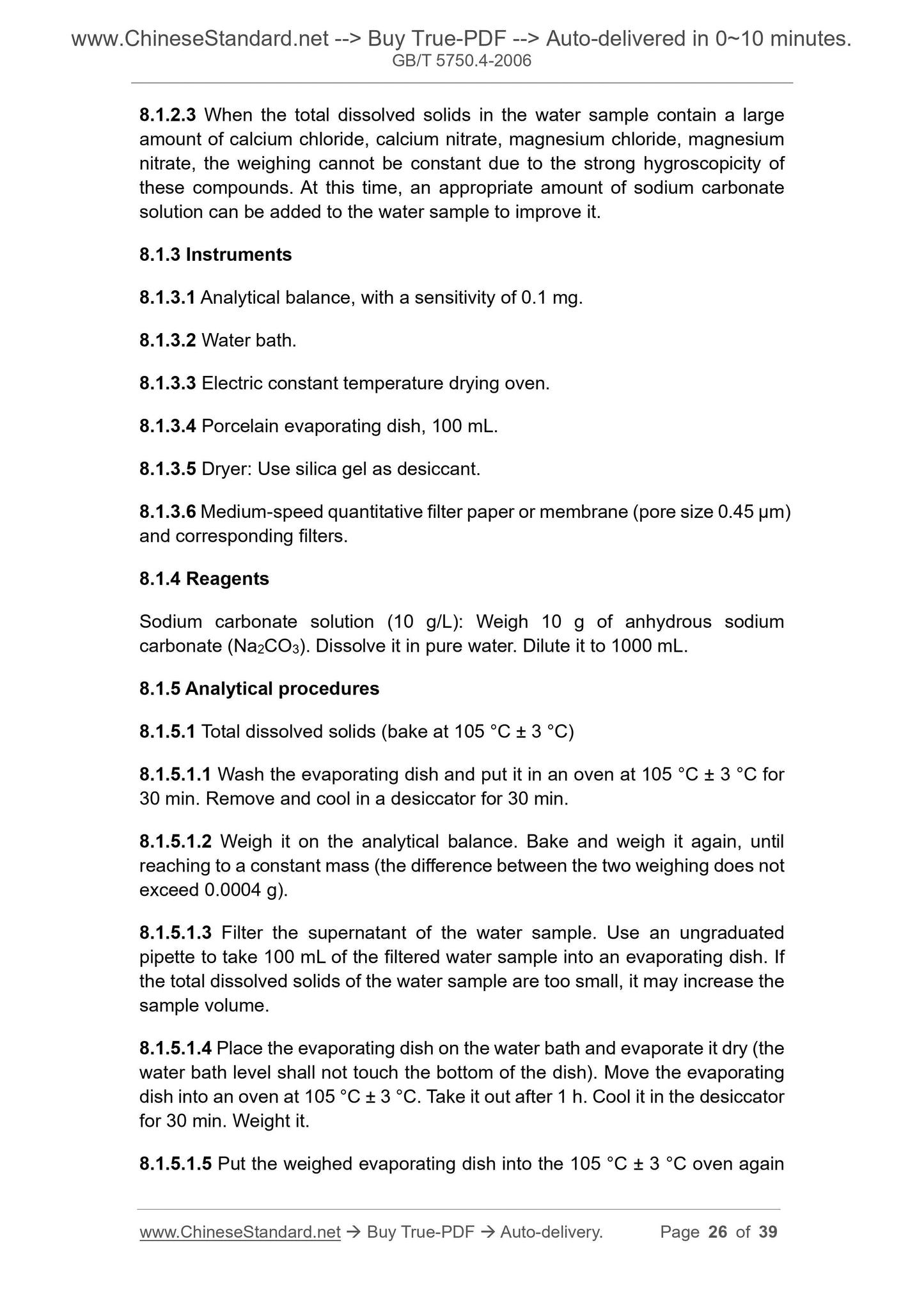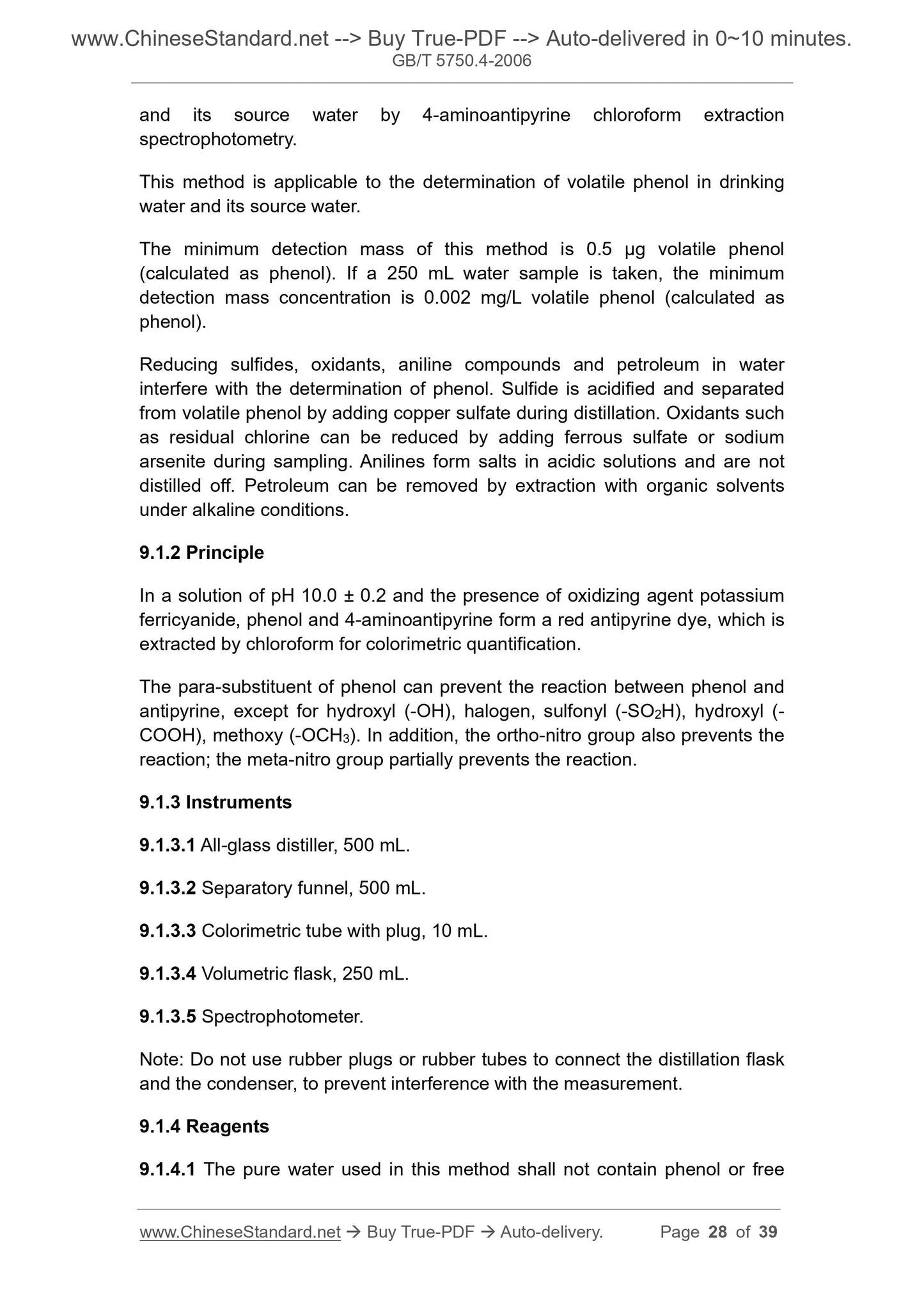1
/
of
12
www.ChineseStandard.us -- Field Test Asia Pte. Ltd.
GB/T 5750.4-2006 English PDF (GB/T5750.4-2006)
GB/T 5750.4-2006 English PDF (GB/T5750.4-2006)
Regular price
$225.00
Regular price
Sale price
$225.00
Unit price
/
per
Shipping calculated at checkout.
Couldn't load pickup availability
GB/T 5750.4-2006: Standard examination methods for drinking water -- Organoleptic and physical parameters
Delivery: 9 seconds. Download (and Email) true-PDF + Invoice.Get Quotation: Click GB/T 5750.4-2006 (Self-service in 1-minute)
Newer / historical versions: GB/T 5750.4-2006
Preview True-PDF
Scope
1.1 Platinum-cobalt standard colorimetry1.1.1 Scope
This standard stipulates the determination of the chroma of drinking water and
its source water by platinum-cobalt standard colorimetry.
This method is applicable to the determination of the chroma of drinking water
and its source water.
The water sample is not diluted. The minimum detection chroma of this method
is 5 degrees. The measurement range is 5 degrees ~ 50 degrees.
The suspended matter in the water sample shall be removed before the
measurement.
1.1.2 Principle
The potassium chloroplatinate and cobalt chloride are used to prepare a
standard color series similar to the natural water’s yellow hue, which is used for
the visual colorimetric determination of water samples. The color of 1 mg/L
platinum [existed in the form of (PtCl6)2- is specified as a color unit, which is
called 1 degree. Even slight turbidity can interfere with the measurement, so
the turbid water sample needs to be centrifuged to make it clear before
measurement.
1.1.3 Reagents
Platinum-cobalt standard solution: Weigh 1.246 g of potassium chloroplatinate
(K2PtCl6) and 10.00 g of dry cobalt chloride (CoCl2 • 6H2O). Dissolve it in 100
mL of pure water. Add 100 mL of hydrochloric acid (ρ20 = 1.19 g/mL). Use pure
water to make the volume reach to 1000 mL. The chroma of this standard
solution is 500 degrees.
1.1.4 Instruments
1.1.4.1 Complete set of high-grade colorless plugged colorimetric tubes, 50 mL.
The minimum detection turbidity of this method is 0.5 nephelometric turbidity
unit (NTU).
Turbidity is an indicator that reflects the physical characteristics of water source
and drinking water. The turbidity of the source water is caused by optical
scattering or absorption behavior due to suspended solids or colloidal
substances, or both.
2.1.2 Principle
Under the same conditions, the intensity of the scattered light of the Formazine
standard suspension is compared with the intensity of scattered light of the
water sample. The greater the intensity of the scattered light, the higher the
turbidity.
2.1.3 Reagents
2.1.3.1 Pure water: Take distilled water and filter through a 0.2 μm membrane
filter.
2.1.3.2 Hydrazine sulfate solution (10 g/L): Weigh 1.000 g of hydrazine sulfate
[(NH2)2 • H2SO4, also known as hydrazine sulfate]. Dissolve it in pure water and
make its volume reach to the mark in a 100 mL volumetric flask.
Note: Hydrazine sulfate is carcinogenic. Avoid inhalation, ingestion, or
skin contact!
2.1.3.3 Cyclo-hexamethylenetetramine solution (100 g/L): Weigh 10.00 g of
cyclo-hexamethylenetetramine [(CH2)6N4]. Dissolve it in pure water and make
its volume reach to the mark in a 100 mL volumetric flask.
2.1.3.4 Standard suspension of Formazine: Respectively pipette 5.00 mL of
hydrazine sulfate solution and 5.00 mL of cyclo-hexamethylenetetramine
solution in a 100 mL volumetric flask. Mix it uniformly. After placing at 25 °C ±
3 °C for 24 h. Add pure water to the mark and mix it uniformly. This standard
suspension has a turbidity of 400 NTU and can be used for about one month.
2.1.3.5 Formazine turbidity standard use solution: Use pure water to dilute the
Formazine turbidity standard suspension (2.1.3.4) 10 times. The turbidity of this
suspension is 40 NTU. It shall be appropriately diluted during use according to
the need.
2.1.4 Instruments
Scattering turbidity meter.
2.1.5 Analytical procedures
5.1.1 Scope
This standard specifies the determination of the pH value of domestic drinking
water and its source water by the glass electrode method.
This method is applicable to the determination of the pH value of domestic
drinking water and its source water.
The pH value determined by this method can be accurate to 0.01.
The pH value is the logarithm of the reciprocal of hydrogen ion’s activity in water.
The chroma, turbidity, free chlorine, oxidant, reducing agent, higher salt content
of water does not interfere with the measurement. However, in a strong alkaline
solution, when a large amount of sodium ions is present, an error will occur,
which will make the reading relatively low.
5.1.2 Principle
The glass electrode is used as the indicator electrode, the saturated calomel
electrode is used as the reference electrode, which are inserted into the solution
to form a primary battery. When the hydrogen ion’s concentration changes, the
electromotive force between the glass electrode and the calomel electrode also
changes. At 25 °C, each unit of the pH scale is equivalent to 59.1 mV
electromotive force’s change, directly represented by the pH reading on the
instrument. There is a temperature difference compensation device on the
instrument.
5.1.3 Reagents
5.1.3.1 Potassium hydrogen phthalate standard buffer solution: Weigh 10.21 g
of potassium hydrogen phthalate (KHC8H4O4) which had been dried at 105 °C
for 2 h. Dissolve it in pure water and dilute to 1000 mL. The pH value of this
solution is 4.00 at 20 °C.
5.1.3.2 Mixed phosphate standard buffer solution: Weigh 3.40 g of potassium
dihydrogen phosphate (KH2PO4) which had been dried at 105 °C for 2 h and
3.55 g of disodium hydrogen phosphate (Na2HPO4). Dissolve it in pure water
and dilute it to 1000 mL. The pH of this solution is 6.88 at 20 °C.
5.1.3.3 Sodium tetraborate standard buffer solution: Weigh 3.81 g of sodium
tetraborate (Na2B4O7 • 10H2O). Dissolve it in pure water. Dilute it to 1000 mL.
The pH value of this solution is 9.22 at 20 °C.
mixed phosphate standard buffer solution for repositioning. If the water
sample’s pH is > 7.0, use sodium tetraborate standard buffer solution for
positioning; use potassium bi-phthalate or mixed phosphate standard buffer
solution for repositioning.
Note: If the positioning values of the three buffers are found to be non-linear, it
shall check the quality of the glass electrode.
5.1.5.4 Use the washing bottle to slowly rinse the two electrodes several times
by pure water. Then use water sample to rinse it for 6 ~ 8 times. Then insert it
into the water sample. After 1 min, directly read the pH value from the
instrument.
Note 1: In the calomel electrode, it is a saturated solution of potassium chloride.
When the room temperature rises, the solution may change from a saturated
state to an unsaturated state, so a certain amount of potassium chloride crystals
shall be maintained.
Note 2: For solutions with a pH value greater than 9, the pH value shall be
measured using a high-alkali glass electrode.
5.2 Standard buffer solution colorimetry
5.2.1 Scope
This standard specifies the standard buffer solution colorimetric method for
measuring the pH of drinking water and its source water.
This method is applicable to the determination of the pH value of drinking water
and its source water with very low chroma and turbidity.
Using this method to determine the pH can be accurate to 0.1.
Water samples are colored, turbid, or contain more free residual chlorine,
oxidants, reducing agents, it has interference.
5.2.2 Principle
Different acid-base indicators show different colors in a certain pH range. Add
the same indicator to a series of standard buffer solutions and water samples
with known pH values. Compare the measured pH values of the water samples
after color development.
5.2.3 Reagents
5.2.3.1 Potassium hydrogen phthalate solution [c(KHC8H4O4) = 0.10 mol/L]:
Place potassium hydrogen phthalate (KHC8H4O4) in an oven at 105 °C for 2 h
and place it in a silica gel dryer to cool it for 30 min. Weigh 20.41 g and dissolve
(mol/L);
m - The mass of potassium hydrogen phthalate, in grams (g);
V - The volume of sodium hydroxide solution used for titration of potassium
hydrogen phthalate, in milliliters (mL);
V0 - The volume of the sodium hydroxide solution used for titrating the blank
solution, in milliliters (mL);
0.2042 - The mass of potassium hydrogen phthalate equivalent to 1.00 mL
of sodium hydroxide standard solution [c(NaOH) = 1.000 mol/L].
According to the concentration of the sodium hydroxide stock solution, calculate
the volume of the stock solution required to prepare 0.1000 mol/L sodium
hydroxide solution according to formula (3). Use pure water to make the volume
reach the required value.
Where:
V1 - The volume of the stock solution, in milliliters (mL);
V2 - The volume after dilution, in milliliters (mL);
c1 (NaOH) - Concentration of stock solution.
5.2.3.5 Chlorophenol red indicator: Weigh 100 mg of chlorophenol red
(C19H12C12O5S). Put it in an agate mortar. Add 23.6 mL of sodium hydroxide
solution (5.2.3.4). Grind until completely dissolving it. Use pure water to make
its volume reach to 250 mL. The applicable pH range of this indicator is 4.8 ~
6.4.
5.2.3.6 Bromothymol blue indicator: Weigh 100 mg bromothymol blue
(C27H28Br2O5S, also known as thymol blue). Place it in an agate mortar. Add
16.0 mL of sodium hydroxide solution (5.2.3.4). The following operations are
the same as (5.2.3.5). The applicable pH range of this indicator is 6.2 ~ 7.6.
5.2.3.7 Phenol red indicator: Weigh 100 mg of phenol red (C19H14O5S). Put it in
an agate mortar. Add 28.2 mL of sodium hydroxide solution (5.2.3.4). The
following operations are the same as (5.2.3.5). The applicable pH range of this
indicator is 6.8 ~ 8.4.
5.2.3.8 Thymol blue indicator: Weigh 100 mg of thymol blue (C27H30O5S, also
known as thymol blue). Put it in an agate mortar. Add 21.5 mL of sodium
hydroxide solution (5.2.3.4). The following operations are the same as (5.2.3.5).
Potassium chloride standard solution [c (KCL) = 0.01000 mol/L]: Weigh 0.7456
g of superior grade pure potassium chloride which had been dried at 110 °C.
Dissolve it in freshly boiled and cooled distilled water (conductivity is less than
1 μS/cm). Dilute it to 1000 mL in a volumetric flask at 25 °C. The conductivity of
this solution at 25 °C is 1413 μS/cm. The solution shall be stored in a plastic
bottle.
6.1.4 Instruments
6.1.4.1 Conductivity meter.
6.1.4.2 Constant temperature water bath.
6.1.5 Analytical procedures
6.1.5.1 Pour the potassium chloride standard solution (6.1.3) into 4 test tubes.
Then inject the water sample into 2 test tubes. Put 6 test tubes into 25 °C ±
0.1 °C constant temperature water bath at the same time. Heat it for 30 min, to
make the temperature of the solution in the tube reach 25 °C.
6.1.5.2 Use three tubes of potassium chloride solution to rinse the conductivity
electrode and conductivity cell in sequence. Then pour the potassium chloride
solution in the fourth tube into the conductivity cell. Insert the conductivity
electrode to measure the conductivity GKCl or resistance RKCl of potassium
chloride.
6.1.5.3 Use one tube of water sample to fully rinse the electrode. Measure the
conductivity Gs, or resistance Rs, of the other tube of water sample.
Measure other water samples in turn. If the temperature change is less than
0.2 °C during the measurement, the conductivity or resistance of the potassium
chloride standard solution does not need to be measured again. However, when
measuring in different batches (days), it shall measure the conductivity or
resistance of potassium chloride solution again.
6.1.6 Calculation
6.1.6.1 Conductivity cell constant C: Equal to the conductivity (1413 μS/cm) of
the potassium chloride standard solution divided by the measured conductivity
GKCL of the potassium chloride standard solution. The temperature during
measurement shall be 25 °C ± 0.1 °C, then:
6.1.6.2 At 25 °C ± 0.1 °C, the conductivity γ of water sample is equal to the cell
constant C multiplied by the measured conductivity of the water sample (μS)
Since the reaction of calcium ion and chrome black T indicator at the end of the
titration cannot show a significant color change, so when the magnesium
content in the water sample is very small, it needs adding a known amount of
magnesium salt to make the color change at the end of the titration clear. When
calculating the results, subtract the amount of magnesium salt added, or add a
small amount of MgEDTA to the buffer solution, to ensure a clear end point.
7.1.2 Principle
The calcium and magnesium ions in the water sample form a purplish red
chelate with the chrome black T indicator. The instability constants of these
chelates are greater than the instability constants of calcium ethylenediamine
tetraacetate and magnesium chelates. When pH = 10, disodium
ethylenediaminetetraacetic acid first forms a chelate with calcium ions and then
magnesium ions. When titrated to the end, the solution appears pure blue with
chrome black T indicator.
7.1.3 Reagents
7.1.3.1 Buffer solution (pH = 10).
7.1.3.1.1 Weigh 16.9 g of ammonium chloride and dissolve it in 143 mL of
ammonia water (ρ20 = 0.88 g/mL).
7.1.3.1.2 Weigh 0.780 g of magnesium sulfate (MgSO4 • 7H2O) and 1.178 g of
ethylenediaminetetraacetic acid disodium (Na2EDTA • 2H2O). Dissolve it in 50
mL of pure water. Add 2 mL of chlorination ammonium-amine hydroxide solution
(7.1.3.1.1) and 5 drops of chrome black T indicator (the solution shall be purple
red. If it is pure blue, a small amount of magnesium sulfate shall be added to
make it purple red). Use Na2EDTA standard solution (7.1.3.5) for titration, until
the solution changes from purple to pure blue. Combine the solutions of
7.1.3.1.1 and 7.1.3.1.2. Use pure water to dilute it to 250 mL. If the solution
turns purple red again after the merger, the reagent blank shall be deducted
when calculating the results.
Note 1: This buffer solution shall be stored in polyethylene bottles or rigid glass
bottles. The pH value is affected by the ammonia loss due to repeated opening
of the plug during use. When the buffer solution is left for a long time and the
ammonia concentration decreases, it shall be prepared again.
Note 2: MgEDTA is added when preparing the buffer solution to make the
titration end point of some water samples with lower magnesium content more
sensitive. If commercial MgEDTA reagents are available, it may directly weigh
1.25 g of MgEDTA add it to 250 mL buffer solution.
Note 3: When chrome black T is used as an indicator, when titrating calcium
and magnesium ions with Na2EDT A, within the pH range of 9.7 ~ 11, the more
c (Na2EDTA) - The concentration of Na2EDTA standard solution, in mole per
liter (mol/L);
c (Zn) - The concentration of zinc standard solution, in moles per liter (mol/L);
V1 - The volume of Na2EDTA solution consumed, in milliliters (mL);
V2 - The volume of the zinc standard solution taken, in milliliters (mL).
7.1.3.6 Chrome black T indicator: Weigh 0.5 g of chrome black T (C20H12O7
N3SNa). Use ethanol [φ(C2H5OH) = 95%] to dissolve it. Dilute it to 100 mL.
Place it in the refrigerator to preserve it. It can be stable for one month.
7.1.4 Instruments
7.1.4.1 Conical flask, 150 mL.
7.1.4.2 Burette, 10 mL or 25 mL.
7.1.5 Analytical procedures
7.1.5.1 Pipette 50.0 mL of water samples (for water samples with too high
hardness, it may take an appropriate amount of water samples, use pure water
to dilute it to 50 mL; for water samples with too low hardness, it may take 100
mL). Place it in a 150 mL conical flask.
7.1.5.2 Add 1 mL ~ 2 mL of buffer solution and 5 drops of chrome black T
indicator. Immediately use Na2EDTA standard solution to titrate it, until the
solution changes from purple red to pure blue. At the same time, carry out a
blank test and record the amount consumed.
7.1.5.3 If the water sample contains metal interfering ions, which delays the
titration end point or darkens the color, it may take another water sample and
add 0.5 mL of hydroxylamine hydrochloride (7.1.3.3) and 1 mL of sodium sulfide
solution (7.1.3.2) or 0.5 mL potassium cyanide solution (7.1.3.4); then titrate it.
7.1.5.4 When the bicarbonate content of calcium and magnesium in the water
sample is large, it shall first acidify the water sample in advance and heat to
remove carbon dioxide, to prevent carbonate precipitation after alkalization,
which will affect the progress of the titration reaction.
7.1.5.5 Water samples containing suspended or amine organics may affect the
observation of the end point. The water sample may be evaporated to dryness
and ashed at 550 °C in advance; then the residue can be titrated after dissolving
the residue in pure water.
7.1.6 Calculation
8.1.2.3 When the total dissolved solids in the water sample contain a large
amount of calcium chloride, calcium nitrate, magnesium chloride, magnesium
nitrate, the weighing cannot be constant due to the strong hygroscopicity of
these compounds. At this time, an appropriate amount of sodium carbonate
solution can be added to the water sample to improve it.
8.1.3 Instruments
8.1.3.1 Analytical balance, with a sensitivity of 0.1 mg.
8.1.3.2 Water bath.
8.1.3.3 Electric constant temperature drying oven.
8.1.3.4 Porcelain evaporating dish, 100 mL.
8.1.3.5 Dryer: Use silica gel as desiccant.
8.1.3.6 Medium-speed quantitative filter paper or membrane (pore size 0.45 μm)
and corresponding filters.
8.1.4 Reagents
Sodium carbonate solution (10 g/L): Weigh 10 g of anhydrous sodium
carbonate (Na2CO3). Dissolve it in pure water. Dilute it to 1000 mL.
8.1.5 Analytical procedures
8.1.5.1 Total dissolved solids (bake at 105 °C ± 3 °C)
8.1.5.1.1 Wash the evaporating dish and put it in an oven at 105 °C ± 3 °C for
30 min. Remove and cool in a desiccator for 30 min.
8.1.5.1.2 Weigh it on the analytical balance. Bake and weigh it again, until
reaching to a constant mass (the difference between the two weighing does not
exceed 0.0004 g).
8.1.5.1.3 Filter the supernatant of the water sample. Use an ungraduated
pipette to take 100 mL of the filtered water sample into an evaporating dish. If
the total dissolved solids of the water sample are too small, it may increase the
sample volume.
8.1.5.1.4 Place the evaporating dish on the water bath and evaporate it dry (the
water bath level shall not touch the bottom of the dish). Move the evaporating
dish into an oven at 105 °C ± 3 °C. Take it out after 1 h. Cool it in the desiccator
for 30 min. Weight it.
8.1.5.1.5 Put the weighed evaporating dish into the 105 °C ± 3 °C oven again
and its source water by 4-aminoantipyrine chloroform extraction
spectrophotometry.
This method is applicable to the determination of volatile phenol in drinking
water and its source water.
The minimum detection mass of this method is 0.5 μg volatile phenol
(calculated as phenol). If a 250 mL water sample is taken, the minimum
detection mass concentration is 0.002 mg/L volatile phenol (calculated as
phenol).
Reducing sulfides, oxidants, aniline compounds and petroleum in water
interfere with the determination of phenol. Sulfide is acidified and separated
from volatile phenol by adding copper sulfate during distillation. Oxidants such
as residual chlorine can be reduced by adding ferrous sulfate or sodium
arsenite during sampling. Anilines form salts in acidic solutions and are not
distilled off. Petroleum can be removed by extraction with organic solvents
under alkaline conditions.
9.1.2 Principle
In a solution of pH 10.0 ± 0.2 and the presence of oxidizing agent potassium
ferricyanide, phenol and 4-aminoantipyrine form a red antipyrine dye, which is
extracted by chloroform for colorimetric quantification.
The para-substituent of phenol can prevent the reaction between phenol and
antipyrine, except for hydroxyl (-OH), halogen, sulfonyl (-SO2H), hydroxyl (-
COOH), methoxy (-OCH3). In addition, the ortho-nitro group also prevents the
reaction; the meta-nitro group partially prevents the reaction.
9.1.3 Instruments
9.1.3.1 All-glass distiller, 500 mL.
9.1.3.2 Separatory funnel, 500 mL.
9.1.3.3 Colorimetric tube with plug, 10 mL.
9.1.3.4 Volumetric flask, 250 mL.
9.1.3.5 Spectrophotometer.
Note: Do not use rubber plugs or rubber tubes to connect the distillation flask
and the condenser, to prevent interference with the measurement.
9.1.4 Reagents
9.1.4.1 The pure water used in this method shall not contain phenol or free
residual chlorine. The preparation method of phenol-free pure water is as
follows: Adding sodium hydroxide to the water to a pH of 12 or more. Perform
distillation. In alkaline solutions, phenols form sodium phenate and are not
distilled off.
9.1.4.2 Chloroform.
9.1.4.3 Copper sulfate solution (100 g/L): Weigh 10 g of copper sulfate (CuSO4
• 5H2O). Dissolve it in pure water. Dilute it to 100 mL.
9.1.4.4 Ammonia water-amine chloride buffer solution (pH9.8): Weigh 20 g of
amine chloride (NH4Cl) and dissolve it in 100 mL of ammonia water (ρ20 = 0.88
g/mL).
9.1.4.5 4-aminoantipyrine solution (20 g/L): Weigh 2.0 g of 4-aminoantipyrine
(4-AAP, C11H13ON3). Dissolve it in pure water and dilute it to 100 mL. Store it in
a brown bottle and prepare immediately before use.
9.1.4.6 Potassium ferricyanide solution (80 g/L): Weigh 8.0 g of potassium
ferricyanide [K3Fe(CN)6]. Dissolve it in pure water. Dilute it to 100 mL. Store it
in a brown bottle and prepare immediately before use.
9.1.4.7 Potassium bromate-potassium bromide solution [c(1/6 KBrO3) = 0.1
mol/L]: Weigh 2.78 g of dry potassium bromate (KBrO3). Dissolve it in pure
water. Add 10 g of bromine potassium (KBr). Dilute it to 1000 mL.
9.1.4.8 Starch solution (5 g/L): Mix 0.5 g of soluble starch into a paste with a
small amount of pure water. Then add freshly boiled pure water to 100 mL. After
cooling, add 0.1 g of salicylic acid or 0.4 g of zinc chloride. Preserve it.
9.1.4.9 Sulfuric acid solution (1 + 9).
9.1.4.10 Phenol standard solution
9.1.4.10.1 Refining of phenol: Take phenol in a distillation flask with an air
condensing tube. Heat to distill it. Collect the distillate at 182 °C ~ 184 °C. The
refined phenol shall be white after cooling. Tightly plug it and store it in the dark.
9.1.4.10.2 Phenol standard stock solution: Dissolve 1 g of white refined phenol
in 1000 mL of pure water. Store it in the refrigerator after calibration.
Calibration of phenol standard stock solution: Pipette 25.00 mL of the phenol
stock solution to be calibrated. Place it in a 250 mL iodine measuring flask. Add
100 mL of pure water. Then accurately add 25.00 mL of potassium bromate-
potassium bromide solution (9.1.4.7). Immediately add 5 mL of hydrochloric
acid (ρ20 = 1.19 g/mL). Cap the plug tightly. Slowly shake it. Let it stand for 10
min. Add 1 g of potassium iodide. Cap the bottle tightly. Shake it uniformly. Place
This method is applicable to the determination of volatile phenols which have a
content of 0.1 mg/L ~ 5.0 mg/L in domestic drinking water and its source water.
The minimum detection mass of this method is 5.0 μg volatile phenol
(calculated as phenol). If a 50 mL water sample is taken for measurement, the
lowest detection mass concentration is 0.10 mg/L volatile phenol (calculated as
phenol).
For the interferences of this method and their elimination methods, see 9.1.1.
9.2.2 Principle
In the solution of pH 10.0 ± 0.2 and the presence of the oxidizing agent
potassium ferricyanide, phenol and 4-aminoantipyrine form a red antipyrine dye,
which is directly subject to colorimetry and quantitation.
See 9.1.2 for the reaction of the phenol’s substituent group and phenol and 4-
aminoantipyrine.
9.2.3 Instruments
Except for the 50 mL colorimetric tube with plug, the other instruments are the
same as 9.1.3.
9.2.4 Reagents
In addition to not using chloroform, other reagents are the same as 9.1.4; the
concentration of phenol standard use solution is: ρ (C6H5OH) = 10 μg/mL.
9.2.5 Analytical procedures
9.2.5.1 Water sample treatment: Same as 9.1.5.1.
9.2.5.1.1 Pipette 50 mL of distillate (or take appropriate amount of pure water
to dilute it to 50 mL) into a 50 mL colorimetric tube with plug.
9.2.5.1.2 Take another seven 50 mL colorimetric tubes. Respectively add 0 mL,
0.50 mL, 1.00 mL, 3.00 mL, 5.00 mL, 7.00 mL, 10.0 mL of standard use solution
which contains 10 μg of phenol (calculated as phenol) per millimeter. Use pure
water to dilute it to 50 mL.
9.2.5.1.3 Add 0.5 mL of buffer solution (9.1.4.4) to the water sample and the
standard. Shake it uniformly. Add 1.0 mL of 4-aminoantipyrine solution (9.1.4.5)
and mix it uniformly. Finally, add 1.0 mL of potassium ferricyanide solution
(9.1.4.6). Mix it uniformly. Let it stand accurately for 10 min. At a wavelength of
510 nm, use a 2 cm cuvette with a blank tube as a reference to measure
absorbance.
10.1.3 Instruments
10.1.3.1 Separatory funnel, 250 mL.
10.1.3.2 Colorimetric tube, 25 mL.
10.1.3.3 Spectrophotometer.
10.1.4 Reagents
10.1.4.1 Chloroform.
10.1.4.2 Methylene blue solution: Weigh 30 mg of methylene blue (C16H18ClN3S
• 3H2O). Dissolve it in 500 mL pure water. Add 6.8 mL of sulfuric acid (ρ20 = 1.84
g/mL) and 50 g of sodium dihydrogen phosphate (NaH2PO4 • H2O). After
dissolution, use pure water to dilute it to 1000 mL.
10.1.4.3 Washing solution: Take 6.8 mL of sulfuric acid (ρ20 = 1.84 g/mL) and
50 g of sodium dihydrogen phosphate. Dissolve it pure water. Dilute it to 1000
mL.
10.1.4.4 Sodium hydroxide solution (40 g/L).
10.1.4.5 Sulfuric acid solution [c(1/2 H2SO4) = 0.5 mol/L]: Take 2.8 mL of sulfuric
acid (ρ20 = 1.84 g/mL) into pure water and dilute it to 100 mL .
10.1.4.6 Sodium dodecylbenzene sulfonate standard stock solution [ρ (DBS) =
1 mg/mL]: Weigh 0.500 g of sodium dodecylbenzene sulfonate (C12H25-C6
H4SO3Na), referred to as DBS). Dissolve it in pure water. Make its volume reach
to 500 mL.
The standard solution of sodium dodecylbenzene sulfonate shall be prepared
by pure products. If there is no pure product, it can be purified from
commercially available anionic detergent. Methods as below:
Use hot ethanol [φ (C2H5OH) = 95%] to treat the washing powder. Filter out
insoluble materials. Heat the filtrate to evaporate to remove part of the ethanol.
Filter it. Discard the filtrate. Re-dissolve the filter residue in a small amount of
hot ethanol. Filter it. Repeat this for 3 times. Then add equal volume of pure
water to the ethanol solution of sodium dodecylbenzene sul...
Basic Data
| Standard ID | GB/T 5750.4-2006 (GB/T5750.4-2006) |
| Description (Translated English) | Standard examination methods for drinking water -- Organoleptic and physical parameters |
| Sector / Industry | National Standard (Recommended) |
| Classification of Chinese Standard | C51 |
| Classification of International Standard | 13.060 |
| Word Count Estimation | 22,267 |
| Date of Issue | 2006-12-29 |
| Date of Implementation | 2007-07-01 |
| Older Standard (superseded by this standard) | GB/T 5750-1985 |
| Regulation (derived from) | China National Standard Approval Announcement 2006 No.12 (Total No.99) |
| Issuing agency(ies) | General Administration of Quality Supervision, Inspection and Quarantine of the People's Republic of China, Standardization Administration of the People's Republic of China |
| Summary | This standard specifies the use of platinum-diamond standard colorimetric determination of drinking water and source water color. This law applies to the determination of drinking water and source water chromaticity. Water samples without dilution, Act 5 degrees minimum detectable colorimetric measurement range of 5 degrees to 50 degrees. Suspended solids in water samples should be removed prior to measurement. |
Share

